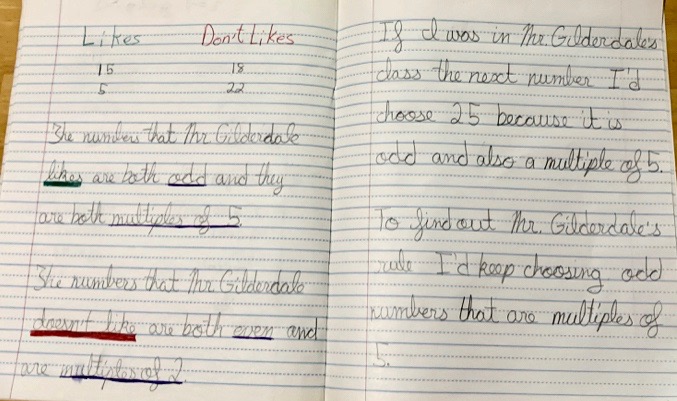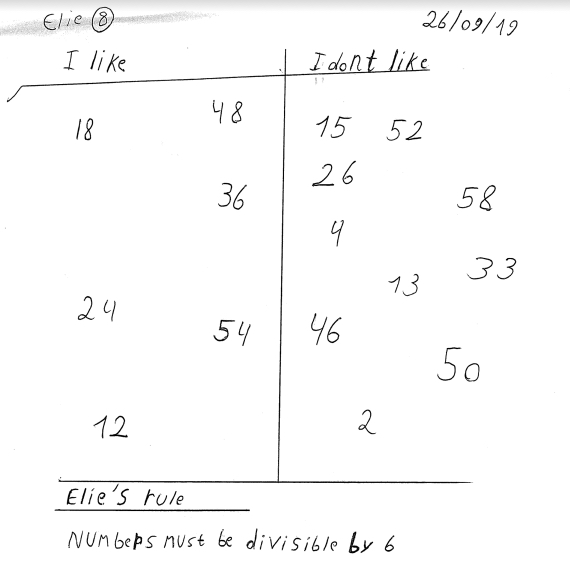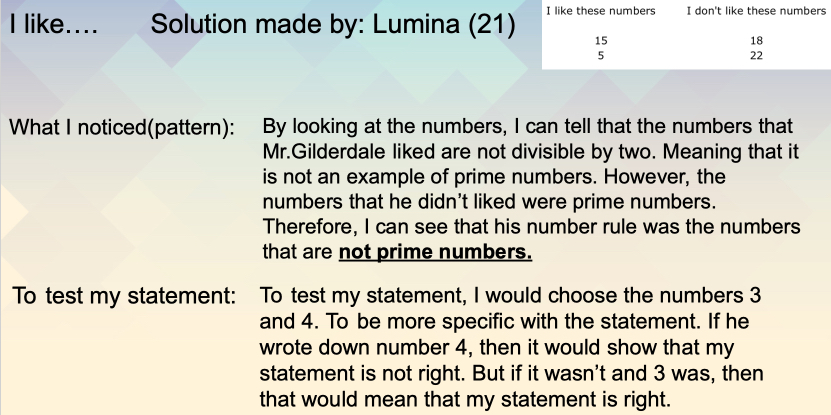Skip over navigation
Alex from Elm Park Primary School in New Zealand sent in the following:
The rule is the number must be divisible by 5.
Because 5 and 15 are both divisible by 5 and 18 and 22 are not.
Haima from Tempo School in Canada sent in this work:

Gwenny who is home-schooled in the United Kingdom wrote:
I think the rules could be:
1) He only likes numbers with 5 in them
2) He only likes odd numbers
3) He only likes numbers in the 5 times table
4) He only likes numbers that have a 5 in the units
To test the rule, I would ask him if he likes the number 53. If he put it in the "don't like" column, we would know it wasn't rule 1 or 2. If he put it in the "like" box, we would know it wasn't rule 3 or 4. My next number to ask would be 50. This way, I would find out if it was odd numbers or numbers with 5 in that he liked.
Elie from The International School of Brussels sent this in:
 click to see full size
click to see full size
and from Lumina:
 click to see full size
click to see full size
Thank you for these observations and thoughts.

Or search by topic
Number and algebra
Geometry and measure
Probability and statistics
Working mathematically
Advanced mathematics
For younger learners
I Like ...
Age 5 to 7
Challenge Level 





- Problem
- Getting Started
- Student Solutions
- Teachers' Resources
Alex from Elm Park Primary School in New Zealand sent in the following:
The rule is the number must be divisible by 5.
Because 5 and 15 are both divisible by 5 and 18 and 22 are not.
Haima from Tempo School in Canada sent in this work:

Gwenny who is home-schooled in the United Kingdom wrote:
I think the rules could be:
1) He only likes numbers with 5 in them
2) He only likes odd numbers
3) He only likes numbers in the 5 times table
4) He only likes numbers that have a 5 in the units
To test the rule, I would ask him if he likes the number 53. If he put it in the "don't like" column, we would know it wasn't rule 1 or 2. If he put it in the "like" box, we would know it wasn't rule 3 or 4. My next number to ask would be 50. This way, I would find out if it was odd numbers or numbers with 5 in that he liked.
Elie from The International School of Brussels sent this in:
 click to see full size
click to see full sizeand from Lumina:
 click to see full size
click to see full sizeThank you for these observations and thoughts.
You may also like
Let's Investigate Triangles
Vincent and Tara are making triangles with the class construction set. They have a pile of strips of different lengths. How many different triangles can they make?

